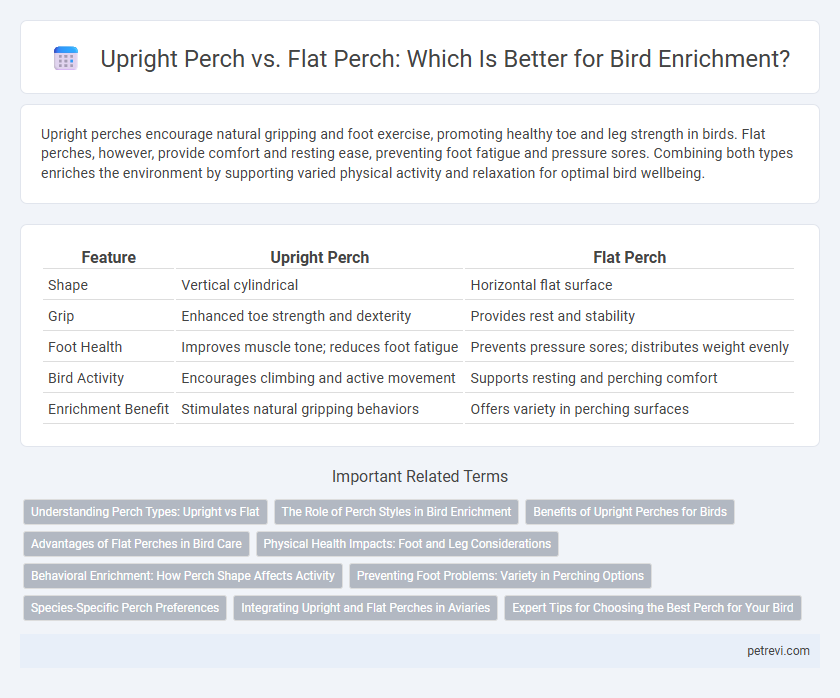Upright perches encourage natural gripping and foot exercise, promoting healthy toe and leg strength in birds. Flat perches, however, provide comfort and resting ease, preventing foot fatigue and pressure sores. Combining both types enriches the environment by supporting varied physical activity and relaxation for optimal bird wellbeing.
Table of Comparison
| Feature | Upright Perch | Flat Perch |
|---|---|---|
| Shape | Vertical cylindrical | Horizontal flat surface |
| Grip | Enhanced toe strength and dexterity | Provides rest and stability |
| Foot Health | Improves muscle tone; reduces foot fatigue | Prevents pressure sores; distributes weight evenly |
| Bird Activity | Encourages climbing and active movement | Supports resting and perching comfort |
| Enrichment Benefit | Stimulates natural gripping behaviors | Offers variety in perching surfaces |
Understanding Perch Types: Upright vs Flat
Upright perches provide birds with a natural gripping experience that promotes foot strength and joint health, mimicking branches in the wild, while flat perches offer a stable, broad surface ideal for resting and reducing pressure points. Both perch types are essential for avian enrichment, contributing to mental stimulation and physical well-being by encouraging varied foot placements and movement. Incorporating a combination of upright and flat perches supports balanced foot development and prevents issues such as pressure sores or arthritis.
The Role of Perch Styles in Bird Enrichment
Upright perches promote natural gripping and foot exercise, enhancing a bird's physical health and preventing arthritis. Flat perches offer a broader surface that supports foot relaxation and reduces pressure sores, benefiting birds prone to pododermatitis. Incorporating both perch styles in an aviary stimulates diverse bird behaviors and contributes to overall enrichment by mimicking varied natural environments.
Benefits of Upright Perches for Birds
Upright perches promote better foot health by encouraging natural gripping and exercise, which helps prevent arthritis and foot sores common in birds. These perches support natural behaviors like climbing and balance, enhancing mental stimulation and reducing stress. Birds using upright perches experience improved muscle tone and joint flexibility, contributing to their overall physical well-being.
Advantages of Flat Perches in Bird Care
Flat perches provide superior foot support and reduce the risk of pressure sores and arthritis in birds, enhancing overall foot health. Their broader surface area encourages natural gripping and prevents foot fatigue, promoting better comfort during rest. These perches also enable birds to engage in more realistic perching behavior, which is essential for mental and physical enrichment in captivity.
Physical Health Impacts: Foot and Leg Considerations
Upright perches promote natural gripping and engage tendons and muscles in a bird's feet and legs, reducing the risk of arthritis and pressure sores. Flat perches distribute weight evenly across the footpad, supporting birds with arthritis or foot injuries and preventing sustained pressure points. Using a variety of perch types enhances physical health by encouraging natural foot movements and preventing conditions like bumblefoot and leg strain.
Behavioral Enrichment: How Perch Shape Affects Activity
Upright perches encourage natural gripping and promote foot muscle exercise, enhancing birds' motor skills and reducing the risk of foot problems. Flat perches provide comfort for resting but may limit dynamic movement and reduce activity levels, potentially leading to decreased behavioral stimulation. Incorporating various perch shapes supports behavioral enrichment by encouraging diverse activities and natural behaviors, vital for avian mental and physical health.
Preventing Foot Problems: Variety in Perching Options
Providing birds with both upright and flat perches is essential for foot health, as these varied shapes help prevent pressure sores and arthritis by distributing weight differently. Upright perches promote natural gripping and exercise of tendons, while flat perches offer broader support, reducing the risk of bumblefoot. Regularly alternating perch types enhances overall foot strength and circulation, crucial for long-term avian wellness.
Species-Specific Perch Preferences
Species-specific perch preferences significantly impact bird enrichment, as upright perches mimic natural branches preferred by parrots and passerines, promoting foot strength and comfort. Flat perches suit species like pigeons and doves, providing stable resting surfaces that reduce pressure points on their feet. Selecting the appropriate perch type enhances natural behaviors and overall avian well-being by catering to anatomical and behavioral needs.
Integrating Upright and Flat Perches in Aviaries
Integrating upright and flat perches in aviaries enhances bird enrichment by mimicking natural habitat structures and promoting diverse physical activity. Upright perches encourage vertical movement and improve grip strength, while flat perches provide comfortable resting spots and reduce foot fatigue. Combining both perch types supports better foot health, mental stimulation, and overall well-being for captive birds.
Expert Tips for Choosing the Best Perch for Your Bird
Upright perches promote natural grip and foot exercise, supporting strong tendon health and reducing the risk of arthritis in birds. Flat perches provide comfortable resting surfaces and are ideal for overweight or elderly birds needing joint relief. Experts recommend alternating between perch types to enhance foot muscle development and prevent pressure sores, ensuring balanced avian enrichment.
Upright perch vs Flat perch for Bird enrichment Infographic

 petrevi.com
petrevi.com